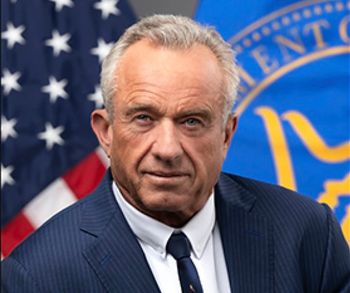
Measles outbreak shows need for vaccination, outreach and primary care
After years with no measles fatalities, three people have died and hundreds of cases have been reported. Dr. Marschall Runge, CEO of Michigan Medicine, talks about the need to take different approaches.
The measles outbreak illustrates the country’s struggles with declining vaccination rates, Dr. Marschall Runge says.
But it also illustrates broader problems with America’s health system, he says. Runge is the CEO of Michigan Medicine, the University of Michigan’s academic medical center. He also serves as the executive vice president for medical affairs at the University of Michigan and dean of the university’s medical school.
Runge watches the measles outbreak with growing concern. After a decade with no reported measles deaths in the U.S., three fatalities have been reported this year.
As of April 3,
“It's frustrating because we know that it's preventable. There was a major push to have high levels of vaccination in the United States, and that's basically what's required to prevent outbreaks. Ninety-five percent of the population has to be vaccinated because this is such a highly contagious disease,” Runge says.
But vaccinations have dropped, and not just for measles, he notes.
In an interview with Chief Healthcare Executive®, Runge talks about rebuilding public trust in vaccines, and medicine more broadly. He talks about the importance of public health efforts and the need to rethink ways of engaging the public. Runge also says the measles outbreak underscores the need for greater attention and investments in primary care.
(See part of our conversation in this video. The story continues below.)
‘Think about different ways’
There are a number of factors contributing to the decline of vaccines, Runge says.
But the prevalence of misinformation about vaccines is a problem that health systems can’t ignore, Runge says.
“There is so much good, and so much bad information that's available through the internet and particularly social media, oftentimes by very authoritative sounding voices,” Runge says. “And people who are hesitant about getting vaccinations, for the children, have said, ‘Oh, well, so-and-so says we shouldn't vaccinate.’”
Runge says those who are considering getting their children vaccinated, or have concerns about their safety, should talk to “trusted voices” in medicine. He says Americans should be talking to doctors, nurses, allied health providers, physicians assistants, and nurse practitioners.
“If you have a question about vaccination, please talk to your health care provider and have a real conversation about it,” Runge says. “I think that's one thing we can do.”
At the same time, health departments, hospitals and providers of all kinds are going to have to develop new methods of reaching the public and engaging with Americans. With many Americans relying on social media, Runge says health systems need to utilize those platforms to reach people.
“I think we have to think about different ways to get the message out,” Runge says.
“I think communicating by social media where people are getting some of their information is important, and I think doing so in a compelling manner,” he adds. “A lot of times that's by stories, by stories of people who had an illness or had an illness that was well treated. So we try to do that, but I think we need to focus more on communicable diseases than we currently do.”
Providers and public health agencies also need to find community partners in areas where people have less access to care, or communities have less trust in the health system. In some communities, the public may be more receptive to messages from community leaders or church leaders about the importance of vaccinations, or other health issues, such as cancer screenings.
Health departments and hospital systems need to think more about outreach in rural areas, especially in counties that may not have a doctor. Outreach efforts for vaccinations may need to include pharmacies or health and wellness centers, Runge says.
Expanding primary care
The measles outbreak also stands as a stark reminder of the nation’s deficiencies in primary care, Runge says.
“Although I think the care for critically ill adults and children is the best in the world, in the United States, we don't perform as well in terms of primary care,” Runge says. “Primary care is harder to obtain in the United States than in many of our peer countries, highly advanced countries. So I think we need to do more in terms of primary care and preventive health than we do.”
The nation’s health system needs to focus more on improving the health of the population, he says.
“I think no area is better suited to do that than primary care,” he says.
And then, he says, with a bit of a smile, “And this is coming from a specialist. I'm a cardiologist. You know, it's a rare day that you'll hear a cardiologist talk about how primary care is even more important than cardiology, but today, I think it is.”
Many Americans are going to urgent care or hospital emergency rooms for some basic healthcare needs, but that doesn’t replace the need for primary care, he says.“That's episodic care and not somebody you have a relationship with,” Runge says. “And we need to be able to provide those kinds of relationships.”
Looking to the future, the nation needs more primary care physicians, and needs to invest in training more doctors for careers in primary care.
“I think we can safely educate many more doctors than we do,” he says, adding, “I think we need to make a significant push in increasing the size of medical school classes.”
Many of those going to medical school are choosing specialty care. In 2022, less than a quarter (24.4%) of new physicians entered primary care, the lowest level in a decade, according to The Milbank Memorial Fund and The Physicians Foundation.
Michigan Medicine has been working to offer financial incentives for those pursuing primary care, and other medical schools have looked at similar strategies.
“It's just a reality that primary care, in today's world, doesn't pay as well as specialties,” he says. “And many people, most people, leave medical school with a debt.”
Runge also stressed the value of having medical school students spending time with primary care physicians in communities, an approach some medical schools are employing.
“It's truly different if they go spend a week or a month or two months with a pediatrician or a family medicine doctor or an internist in a community … And I think if they saw that kind of engagement, which is a very different kind of engagement than you have in a typical academic medical center, I think that would interest people,” he says.






































